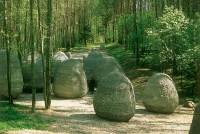
A few miles north of Vilnius town centre, Lithuanian sculptor Gintaras Karosas founded the Europos Parkas (European Park) on a 55-hectare site that encompasses the geographic centre of Europe, as determined by the French National Geographic Institute in 1989.The Park attracts hundreds of thousands of visitors each year, who come to stand in the centre of the continent and admire a permanent outdoor sculpture exhibition, set amid rolling hills, woods and fields dotted with natural springs.About 100 works by artists from dozens of different countries are on display. Guided tours are available, and the site includes a small restaurant, shop and post office. European Park is also a really lovely place to enjoy a walk in the natural surroundings and have a picnic.Autumn is particularly beautiful because of the striking colour of the trees and vegetation but it still remains gorgeous through spring and summer too. In winter, it's perhaps a bit cold but an invigorating stroll through the snowy landscape can be fun, as gates are open all year round.If you are travelling in Lithuania with children, then Europos Parkas is the ideal family excursion from Vilnius. It's a good opportunity to enjoy some fresh air and let the kids get rid of some energy. Lovers of contemporary art will also enjoy the park, where the sculptures are well integrated into the natural scenery.
Website : www.europosparkas.lt
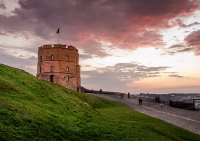
Standing guard over the city of Vilnius since the 13th century, the landmark Gediminas Castle was built by the founder of the city and has served as defence bastion, prison, and now major tourist attraction.Originally, the castle was made of wood, later clad in 10-foot (3m) thick stone walls, and then all but destroyed by Russian troops in the 17th century. Now completely and carefully restored to its former glory, the top of the majestic octagonal tower provides a breath-taking view of the old city.It is the highest point in the Vilnius Old Town, which itself is a UNESCO-listed site. The castle also contains a museum depicting the history of Lithuania and Vilnius, with exhibits including models of the city at various points in history as well as archaeological finds from the region.The castle is also an emotional landmark for those who remember the Baltic Chain, or Chain of Freedom, a peaceful political movement which united the three Balkan states in their fight for independence back in 1989 when Lithuania, Estonia and Latvia were republics of the Soviet Union.The Baltic Chain was a demonstration in which more than two million people joined hands in August 1989 to create a human chain spanning the three Baltic countries to demonstrate their solidarity and their desire for freedom. The chain, a memorable and impactful moment in European history, ended at Gediminas Castle in Lithuania.
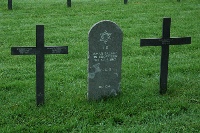
In the early 20th century, about half of the population of Vilnius were Yiddish-speaking Jews and the city was dubbed the 'Jerusalem of the North'. The Nazis in World War II effectively obliterated this community, encircling the Jewish quarter in barbed wire.They marched the 60,000 or so residents into the Paneriai Forest and executed them. Sadly, some sources estimate that the number of Jews killed in Vilnius was far higher. Today, the Genocide Museum has been established at the killing field in memory of the victims of this horror.There is also a Jewish Museum depicting pre-war Jewish life and visitors are welcome at the only remaining Vilnius Synagogue. The Jews were once numerous in Lithuania, with efforts now underway to rebuild and restore many aspects of the former Jewish Quarter.Incredibly, some say that Vilnius once housed more than a hundred synagogues, not to mention schools, libraries and other cultural institutions. Tours of Jewish Vilnius incorporate these sombre but extremely worthwhile historical and cultural attractions.Several private operators offer these tours which should captivate any visitors with an interest in Jewish culture or European history. However, young children may not be prepared for the realities of these tragic sites.
Website : www.jmuseum.lt
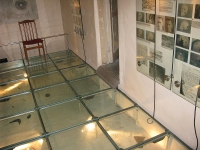
The dark days of the Soviet occupation of Lithuania are preserved in this disturbing collection, which is contained in the former KGB headquarters building; a building which is a symbol of hardship for the Lithuanian population old enough to remember the realities of the occupation.Those who drew the antagonism of the authorities were detained, tortured and often executed in this building. The Museum of Genocide (Genocido Auku Muziejus) is also often called the KGB Museum and the building remains almost exactly the same as it was during Soviet occupation.Some of the museum's exhibitions include the 'Eavesdropping Room', highlighting the use of secret surveillance by the KGB, and 'Life Goes On', a look at the day to day living of Lithuanian deportees and prisoners.There is also the haunting experience of the prison in the basement. Audio guides are available for a small cost and they bring the place vividly to life. Guided tours of the museum are also available in English.The Genocide Museum is one of the top-rated tourist attractions in Vilnius and the collection is informative, well-organised and haunting. Visitors should note that some of the material is rather macabre and may not be suitable for young children.
Website : www.genocid.lt/muziejus
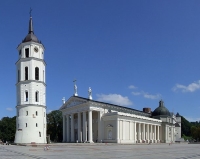
The resplendent Vilnius Cathedral, which stands proudly on the central square of the Old City, has a chequered history that left it decaying and abandoned through the Soviet era. The Cathedral now resembles a classical Greek temple more than it does a Christian church.It's now once again the pride of the city, filled with incredible artworks, traditional icons and history. The cathedral, originally built in the 13th-century, stands on the site of an ancient pagan temple. Rebuilt several times in the succeeding centuries after fires and storm damage, Vilnius Cathedral is an unusual and architecturally impactful cathedral, containing more than 40 paintings and frescoes.There are a number of chapels which are interesting in their own right, located around the premises. Most noteworthy is the Casimir Chapel, first constructed in 1623, containing eight silver-plated statues and décor wrought by artist Constantino Tencallo. No matter what their religion, visitors tend to find the cathedral impressive and the grounds peaceful and attractive.Vilnius has some amazing churches and other special attractions in the city include the St Peter and St Paul Church, which houses numerous sculptures, and St Anne's Church, a beautiful Gothic building.
Website : www.katedra.lt

Travel Guide powered by Word Travels, copyright © 2023 Globe Media Ltd. By its very nature information in this travel guide is subject to change at short notice and travellers are urged to verify information on which they're relying with the relevant authorities. Neither Globe Media Ltd nor Travel Vogue can accept any responsibility for any loss or inconvenience to any person as a result of information contained above.